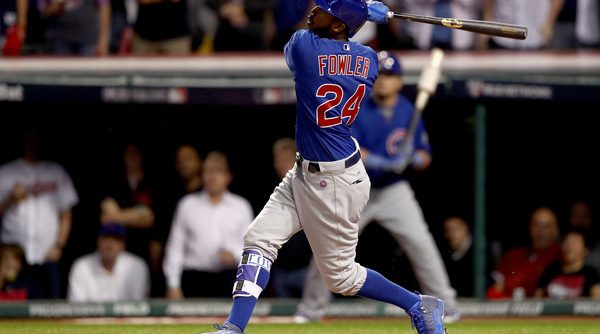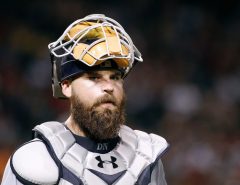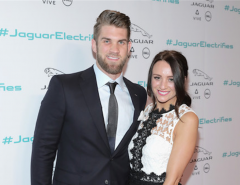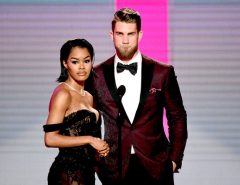This is the third of three parts in my offseason preview series. If you want to know more about the methodology, check out part one here. You should also just read the first two parts anyway! I feel like that’s a natural reaction when you stumble on part three of something. Part two is here.
Left Fielders
BR WAR Rank: #26
Room for improvement? No
Jayson Werth has reached the final year of his seven-year, $126 million deal relatively intact. He was solid in 2016, posting an almost exactly league-average offensive line with below-average defense and coming out to about 1 WAR. It would be hard to see him improving on that, so that is roughly the best-case scenario.
Even if he gets hurt, his backups seem capable of cobbling together 1 WAR. Chris Heisey won’t homer on 19% of his fly balls like he did last season, but he can get some starts in a pinch. Based on the praise he received last September, Brian Goodwin would seem to have the inside track on the lefty OF/backup CF bench job. He tore up AAA last year, so 1 WAR doesn’t seem out of reach for him either. And if the Nats add a backup 1B-type that can play left like Brandon Moss, then it’s all the easier.
Center Fielders
BR WAR Rank: #22
Room for improvement? Yes
It was an odd year for Nationals center fielders. They were by far the worst in baseball in the early going, as Michael A. Taylor and Ben Revere struggled through miserable offensive seasons. Taylor’s 72 wRC+ looks downright sterling when compared to Revere’s putrid 47. But Trea Turner came up and tore it up, with his stellar bat and solid defense despite not playing outfield since high school. Revere and Taylor combined to play roughly 70 percent of the team’s center field innings, meaning that altogether, Turner’s excellent was not enough to bring the group past well below average. But in keeping with the theme of this article, that just means there’s more room to grow!
As mentioned in the shortstops section, Turner would represent a big upgrade if the team decided to keep him in center. A full offseason and spring of working on his outfield defense could conceivably make him an above-average defender, which along with his bat would make him very valuable. But the offensive bar for center fielders is higher, so it seems Turner would be more valuable back at his original position of shortstop. If that’s the case, the Nationals will have a lot of options to replace him.
Despite the team’s struggles at the position in 2016, it’s possible that the 2017 centerfielder is already in the organization. Revere struggled after hurting his oblique on Opening Day; could the Nationals bank on a return to form? Could Bryce Harper return to a position he played 100 innings at in 2015? Or could Goodwin, who raked at AAA and impressed in a brief major league cameo, get a shot to platoon with Taylor? That list of rhetorical questions is exhaustive; prospects like Andrew Stevenson and Victor Robles are not yet ready.
Though there are options, I find it very hard to imagine any of these happening unless the Nationals are certain Revere was hurt and will once again be healthy. Goodwin is much too big a risk, and after Harper’s 2016 was diminished by injury, keeping him healthy will be a focus for 2017.
The free agent market has several high-end options and a few more bargain-basement guys, but no one in between with whom the Nationals could balance their need for an outfielder with their limited budget. One player, however, is a perfect fit: Dexter Fowler. The former Chicago Cub has always had a strong bat, but the metrics have disliked his defense in center. This past season he put it all together, with career highs in wRC+ (126), OBP (.393), and bWAR (4.2). He also had his best dWAR since 2010, as he played deeper on the advice of Cubs coaches and found better fortune in the field.
Now, the downside: Fowler will be 31 next season and will cost the Nationals a draft pick. But the Nationals have a low first pick and can handle his age: After 2017, he can move to left field and replace the departing Werth. Despite his production, the points against him have dragged his apparent market value down to unbelievable levels. FanRag’s Jon Heyman projects him to get just four years and $60 million; MLBTR’s staff projects four years and $64 million; FanGraphs’ Dave Cameron projects four years and $70 million; ESPN’s Jim Bowden projects 5 years and $80 million; and ESPN’s Keith Law offers a soft prediction of up to four years and $90 million. Law’s high outlier aside, those average annual values range from $15-17.5 million. Players in that range now include Pablo Sandoval, Scott Kazmir, and Andre Ethier. Needless to say, he would be a steal and a perfect fit on this roster.
Should a pursuit of Fowler fail, the Nationals could re-up their interest in Yoenis Cespedes, for whom they came in second place last offseason. But he prefers playing left field instead of center and might be prohibitively expensive. Old friend Ian Desmond flourished for half a season in Texas, but he wilted in the second half and did not leave Washington on the best of terms. Carlos Gomez was bad enough to get DFA’d by the Astros midseason but finished the year with an OPS over .900 in 33 games with the Rangers. Once a star and only 31 in December, he could be a nice lottery ticket.
That’s pretty much it for starters, though World Series Game 7 hero Rajai Davis is a borderline option despite posting a .306 OBP at age 35 last year. So too is Jon Jay, who can get on base but not play defense or stay healthy.
As always, there is a boatload of trade options. The one you’ve heard the most about is surely Andrew McCutchen, the Pirates star and Nats killer (career .333/.402/.644 line against). After five straight years of Hall-of-Fame-level production, he fell off on both sides of the ball in 2016. His bat remained above average, even though his OBP and SLG both fell 60 points. But his defense cratered to the point that bWAR considered him below replacement level. He is on a dirt-cheap deal that will pay him $14 million in 2017 with a $14.75 million 2018 option, but with two stud corner outfielders that could play center, the low-budget Pirates are reportedly listening to offers on the face of their franchise.
It seems impossible that a player like him could move, but reports indicate the Nationals made a run at him at last year’s trade deadline. If the Nats can land him and he returns to form, they would boast one of baseball’s most formidable lineups.
Another player the Nationals reportedly chased last July was Rockies center fielder Charlie Blackmon. He was an offensive force last year, hitting .324/.381/.552 — a line that was good for a 130 wRC+, even in Coors Field. But with the emergence of überprospect David Dahl, could he be had for young, controllable pitching? That is something the Nationals have in spades.
The list goes on from there. The Yankees may want to trade Brett Gardner or Jacoby Ellsbury, though the latter is still owed $90 million. The Nationals could also try to pry a center fielder from a divisional rival, such as Odubel Herrera, Ender Inciarte, or Marcell Ozuna.
Most tantalizingly, could the Nationals back up the truck and attempt to assemble a package for the best player in the game: Angels center fielder Mike Trout? Trout is supremely valuable, but with the Angels struggling to build a competitive team around him and sporting one of baseball’s worst farm systems, it’s not insane to imagine they might try to cash in the game’s biggest chip. Any deal would surely decimate the farm system and include a number of young MLB pieces, including but not limited to the likes of Turner and Joe Ross. For Trout, no price is too high. Any trade is a pipe dream, but a really fun one to imagine.
Right Fielders
BR WAR Rank: #18
Room for improvement? Yes
Speaking of the best player in baseball, Bryce Harper was that in 2015. But his bat and defense fell off in 2016, likely due to a neck/shoulder injury that he and the team oddly denied and ignored. His OPS fell almost 300 points, but even diminished Bryce was good for 3.5 fWAR and an All-Star berth.
It has been discussed very little at this point in the offseason, but the Nationals’ biggest opportunity for improvement lies in a return to form for Harper. If he can resume his 2015 form, which he certainly should with health, he would represent an improvement of six to eight wins (depending on whether you believe FanGraphs or Baseball Reference, respectively). That’s the same improvement they would see if they swapped out Werth for Trout, or Gio Gonzalez for Clayton Kershaw AND Joe Ross for Noah Syndergaard. Eight additional wins would increase the fWAR of the 2016 starting lineup (no pitcher) by almost 40 percent. The fWAR difference between the 2016 Nationals lineup and the 2016 NL All-Star lineup was only 15 wins. To wit: Harper returning to form would be colossal.
The 2016 Nationals were an excellent team. They won 95 games and came remarkably close to winning the first playoff series for a D.C. baseball team in 92 years. But based on the 5,000 words before this, it’s very possible that the 2017 edition is even better.
For some very quick math, let’s assume the positions with entrenched starters except for right field stay the same: pitchers, first base, second base, third base, and left field. Of course, injuries represent a threat to all of those numbers, but those are more of a reason to take the final result with a grain of salt rather than something to factor in quantitatively. Let’s say (pessimistically) that the Nationals leave catcher largely unaddressed, and output from that position drops by three wins from 2016. We can also assume Turner will shift from center to short, where he represents a two-win upgrade. We’ll also make one more conservative assumption: that the center field solution is uninspiring and approximates the team’s 2016 production from that spot (roughly two wins, based on Turner’s success and Revere’s and Taylor’s failure).
Add those up, and you get to -1 expected wins… before you consider any major additions or improvement from Harper. If the Nationals add a big closer, that could be worth a win or two. If they sign Fowler or get Blackmon, they might gain two wins in center field instead of none. If they pick up a bonafide starting catcher, they might fall just one win there instead of three. But even if they do none of those things, that leaves them at 94 wins — a near-certain playoff berth and likely division title — without any return to form from the 2015 MVP. With health and effectiveness from the rest of the team (seriously, knock on wood), the sky could be the limit for this team behind a healthy Harper.
Tags: Andrew McCutchen, Andrew Stevenson, Ben Revere, Brandon Moss, Brett Gardner, Brian Goodwin, Bryce Harper, Carlos Gomez, Charlie Blackmon, Chris Heisey, Dexter Fowler, Ender Inciarte, Ian Desmond, Jacoby Ellsbury, Jayson Werth, Joe Ross, Jon Jay, Marcell Ozuna, Michael A Taylor, Nationals, Nats, Odubel Herrera, Rajai Davis, Trea Turner, Victor Robles, Washington Nationals, Yoenis Cespedes




Leave a Reply